See also
48°50′N122°30′W / 48.833°N 122.500°W
The Nooksack Valley refers the collection of mountain valleys within the North Cascades centered around Mount Shuksan, Mount Baker and the Twin Sisters, formed by the catchments of the upper Nooksack River and its alpine tributaries (primarily the North Fork, Middle Fork and South Fork). Roughly covering the western half of Washington state's Whatcom County and a small northern fringe of Skagit County, the Nooksack valleys expands between the Sumas Mountain and Stewart Mountain (between which the valley proper is located) to the west; the Red Mountain, Church Mountain and Goat Mountain in the north; the Ruth Mountain, Icy Peak and Nooksack Cirque in the east; and the Lyman Hill and Mount Josephine in the south.
Out of the three main tributary valleys, the North Fork Valley communicates with the Columbia Valley in the north via a decently wide mountain pass between the Sumas and Red Mountain, where the Washington State Route 547 goes through from Kendall to Peaceful Valley; and the South Fork Valley communicates with the Skagit Valley in the south via a narrow pass between Stewart/Anderson Mountain and Lyman Hill, where the State Route 9 goes through from Saxon to Prairie.
The Nooksack Valley proper beings at the confluence of the North and South Forks east of Deming about 740 m (0.46 mi) south of the T-junction roundabout between State Route 9 and 542, and finishes at the western end of the Sumas-Stewart gap (where the State Route 9 and 542 split apart again) around Cedarville and Lawrence, after which the Nooksack River enters the American side of the Fraser Lowland (known as the "Nooksack Lowland") and courses northwest towards Everson and Lynden, then turns southwest towards Ferndale before bending south to empty into the Bellingham Bay between the city of Bellingham and the Lummi Indian Reservation.
48°50′N122°30′W / 48.833°N 122.500°W

Mount Baker, also known as Koma Kulshan or simply Kulshan, is a 10,781 ft (3,286 m) active glacier-covered andesitic stratovolcano in the Cascade Volcanic Arc and the North Cascades of Washington in the United States. Mount Baker has the second-most thermally active crater in the Cascade Range after Mount St. Helens. About 30 miles (48 km) due east of the city of Bellingham, Whatcom County, Mount Baker is the youngest volcano in the Mount Baker volcanic field. While volcanism has persisted here for some 1.5 million years, the current volcanic cone is likely no more than 140,000 years old, and possibly no older than 80–90,000 years. Older volcanic edifices have mostly eroded away due to glaciation.

Whatcom County is a county located in the northwestern corner of the U.S. state of Washington, bordered by the Lower Mainland of British Columbia to the north, Okanogan County to the east, Skagit County to the south, San Juan County across Rosario Strait to the southwest, and the Strait of Georgia to the west. Its county seat and largest population center is the coastal city of Bellingham, comprising the Bellingham, WA Metropolitan Statistical Area, and as of the 2020 census, the county's population was 226,847.
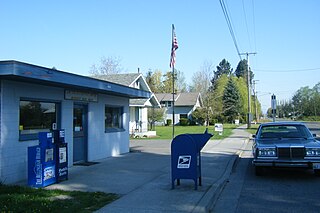
Nooksack is a city in Whatcom County, Washington, 8 km (5.0 mi) south of the border with Canada. The population was 1,471 at the 2020 census. Despite the name, it is actually located right next to the upper stream of the Sumas River, and is 2 km (1.2 mi) northeast of the nearest bank of the Nooksack River.
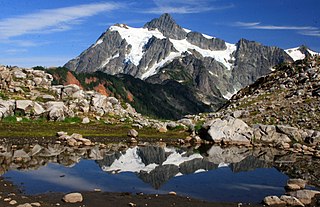
The North Cascades are a section of the Cascade Range of western North America. They span the border between the Canadian province of British Columbia and the U.S. state of Washington and are officially named in the U.S. and Canada as the Cascade Mountains. The portion in Canada is known to Americans as the Canadian Cascades, a designation that also includes the mountains above the east bank of the Fraser Canyon as far north as the town of Lytton, at the confluence of the Thompson and Fraser Rivers.

The Nooksack River is a river in western Whatcom County of the northwestern U.S. state of Washington, draining extensive valley systems within the North Cascades around Mount Shuksan, Mount Baker and the Twin Sisters, and a portion of Fraser Lowland south of the Canada–United States border.
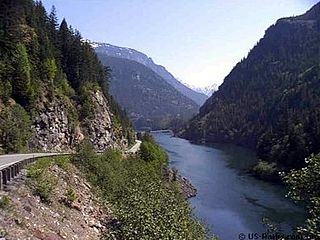
The Skagit River is a river in southwestern British Columbia in Canada and northwestern Washington in the United States, approximately 150 mi (240 km) long. The river and its tributaries drain an area of 1.7 million acres (690,000 hectares) of the Cascade Range along the northern end of Puget Sound and flows into the sound.

The Sauk River is a tributary of the Skagit River, approximately 45 miles (72 km) long, in northwestern Washington in the United States. It drains an area of the high Cascade Range in the watershed of Puget Sound north of Seattle. The river is a popular destination for fly fishing. It is a National Wild and Scenic River.
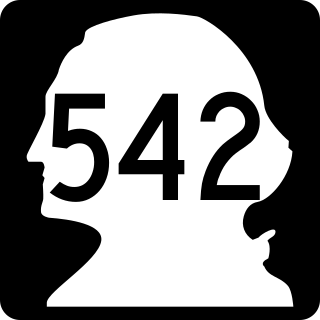
State Route 542 (SR 542) is a 57.24-mile-long (92.12 km) state highway in the U.S. state of Washington, serving Mount Baker in Whatcom County. SR 542 travels east as the Mount Baker Highway from an interchange with Interstate 5 (I-5) in Bellingham through the Nooksack River valley to the Mt. Baker Ski Area at Austin Pass. It serves as the main highway to Mount Baker and the communities of Deming, Kendall, and Maple Falls along the Nooksack River. The highway was constructed in 1893 by Whatcom County as a wagon road between Bellingham and Maple Falls and was added to the state highway system as a branch of State Road 1 in 1925. The branch was transferred to Primary State Highway 1 (PSH 1) during its creation in 1937 and became SR 542 during the 1964 highway renumbering.

State Route 9 (SR 9) is a 98.17-mile (157.99 km) long state highway traversing three counties, Snohomish, Skagit, and Whatcom, in the U.S. state of Washington. The highway extends north from an interchange with SR 522 in the vicinity of Woodinville north through Snohomish, Lake Stevens, Arlington, Sedro-Woolley, and Nooksack to become British Columbia Highway 11 (BC 11) at the Canada–US border in Sumas. Three other roadways are briefly concurrent with the route: SR 530 in Arlington, SR 20 in Sedro-Woolley, and SR 542 near Deming. A spur route in Sumas serves trucks traveling into British Columbia.
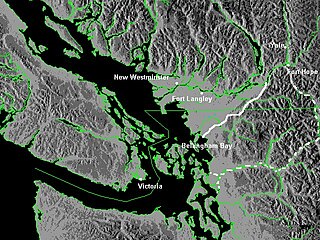
The Whatcom Trail was an overland trail from the Puget Sound area of Washington Territory during the Fraser Canyon Gold Rush of 1858. The trail began on Bellingham Bay, at Fairhaven, the route used went via a route known as the Columbia Valley, which is a lowland route connecting the mid-Nooksack River area with Cultus Lake and the lower Chilliwack River in the Upper Fraser Valley, about 80 km east of today's Vancouver. In 1858, T. G. Richards built the first brick building in Washington as an outfitter for those using the Whatcom Trail.
Sumas Mountain is a mountain located in Whatcom County, Washington, 15 miles northeast of Bellingham and southwest of Vedder Mountain. Located in the Skagit Range, the mountain is notable for its high biodiversity and year-round hiking trails. It is sometimes referred to as American Sumas to distinguish it from an identically named mountain across the Canada–United States border in British Columbia just 10 km (6.2 mi) to the north, both of which are drained by tributary creeks of the Sumas River.

Sumas Lake(Halq’eméyle: Semá:th Lake, Nooksack: Semáts Xácho7, ) was a shallow freshwater lake surrounded by extensive wetlands that once existed in eastern Fraser Lowland, located on the south side of the Sumas River between the foothills of Sumas Mountain and Vedder Mountain. It disappeared after being artificially drained for flood control and land reclamation from 1920 to 1924, leaving behind a low-lying flatland known as the Sumas Prairie, which is nowadays drained by the Saar Creek and the namesaked Sumas Drainage Canal.

State Route 544 is a state highway in northern Whatcom County, Washington, United States. It runs east–west for 9 miles (14 km) near the Canadian border, connecting SR 539 near Lynden to Everson and a junction with SR 9 in Nooksack.
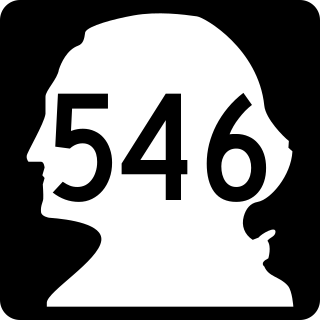
State Route 546 (SR 546) is a state highway in Whatcom County, Washington, United States. It runs east–west for 8 miles (13 km) near the Canadian border, connecting SR 539 near Lynden to SR 9 near Nooksack and Sumas. The highway is a major freight corridor and serves as an alternate route between Bellingham and the Sumas border crossing.

State Route 547 (SR 547) is a Washington state highway located in Whatcom County, south of the Canada–US border. The 10.79-mile (17.36 km) long route runs northwest from SR 542 in Kendall to SR 9 in Sumas. The highway was originally created in 1984, but a road extending from Kendall to Sumas has been on maps since 1966 along the Sumas–Glacier route of the Chicago, Milwaukee, St. Paul and Pacific Railroad.

The Sumas River is a river in the Fraser Lowland and a tributary of the Fraser River system, coursing across the international border between the Canadian province of British Columbia and the U.S. state of Washington.

The Skagit Range is a subrange of the Cascade Range in southwestern British Columbia, Canada and northwestern Washington, United States, which are known in Canada as the Canadian Cascades or, officially, the Cascade Mountains. It is also known in the Nooksack language as Nexwx̠ex̠tsán. The Skagit Range lies to the west of the Skagit River and east and north of the Chilliwack River and flanks the Upper Fraser Valley region of British Columbia's Lower Mainland.
Bellingham Bay and British Columbia Railroad was built in the northwestern part of Washington, between the town of Whatcom, now Bellingham, then to the town of Sumas, to connect with the Canadian Pacific Railway for a continental connection.

The Fraser Lowland is a landform and physiographic region in the Pacific Northwest of North America, shared between the Canadian province of British Columbia and the U.S. state of Washington. The region includes much of the Lower Mainland region of British Columbia, and the coastal plains of Washington's Whatcom County. As a physiographic region, the Fraser Lowland is part of the Georgia Depression, which in turn is part of the Coastal Trough.
Sumas Prairie is a landform in British Columbia, Canada and the State of Washington, United States. Part of the Fraser Lowland, it was created by the draining of Sumas Lake early in the 20th Century, and extends from the Vedder Canal southwestwards into northern Whatcom County, Washington. The British Columbia Highway 1 traverses the former lakebed on the prairie between Abbotsford and Chilliwack.